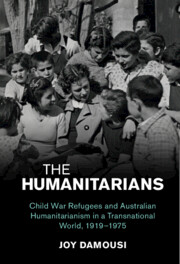 The Humanitarians
The Humanitarians Book contents
- The Humanitarians
- Studies in the Social and Cultural History of Modern Warfare
- The Humanitarians
- Copyright page
- Dedication
- Contents
- Acknowledgements
- Abbreviations
- Introduction
- Part I Saving
- 1 Save the Children Fund in the Antipodes
- 2 The Australasian Orphanage at Antilyas
- Part II Evacuating
- Part III Assimilating and Adopting
- Conclusion
- Select Bibliography
- Index
2 - The Australasian Orphanage at Antilyas
Near East Relief and American Networks 1920s–1930s
from Part I - Saving
Published online by Cambridge University Press: 28 July 2022
- The Humanitarians
- Studies in the Social and Cultural History of Modern Warfare
- The Humanitarians
- Copyright page
- Dedication
- Contents
- Acknowledgements
- Abbreviations
- Introduction
- Part I Saving
- 1 Save the Children Fund in the Antipodes
- 2 The Australasian Orphanage at Antilyas
- Part II Evacuating
- Part III Assimilating and Adopting
- Conclusion
- Select Bibliography
- Index
Summary
Chapter 2 focuses on the Armenian Relief Fund and the Armenian Australasian Orphanage in Antilyas, in modern-day Lebanon. Children are rarely identified as the agents of change in international diplomacy, but during the immediate post-war period, the plight of the children was viewed as vital to the Armenian Relief Fund, created in 1915. This organisation defined Australian internationalism and humanitarianism during the interwar years. The Australasian Orphanage was established in 1923 and supported by the Near East Relief Fund in collaboration with American humanitarians. The Orphanage was a direct way to promote saving the refugees, and the campaign attracted significant support in Australia. The leading figures of this campaign – humanitarian activists Loyal Lincoln Wirt, Mary Serle, Reverend James Creswell, Edith Glanville and Ernest and Mary Bryce – energetically promoted the cause of those affected by the Armenian genocide, and the Orphanage became the focus of their efforts. This campaign is significant too because on many occasions efforts were made to transport Armenian orphans to Australia to save them, challenging the rigidity of the White Australia policy. Importantly, Mary and Ernest Bryce were the only activists who connected both the Armenian and Indigenous causes, identifying the destruction of Indigenous Australians as a genocide in the same way the destruction of the Armenian communities was described. In the Australian context, this campaign, it is argued, also marked a new break from British ties to a collaboration with American humanitarians.
- Type
- Chapter
- Information
- The HumanitariansChild War Refugees and Australian Humanitarianism in a Transnational World, 1919–1975, pp. 51 - 82Publisher: Cambridge University PressPrint publication year: 2022
